1lumen selects and reviews products personally. We may earn affiliate commissions through our links, which help support our testing.
Niwalker ES2 review
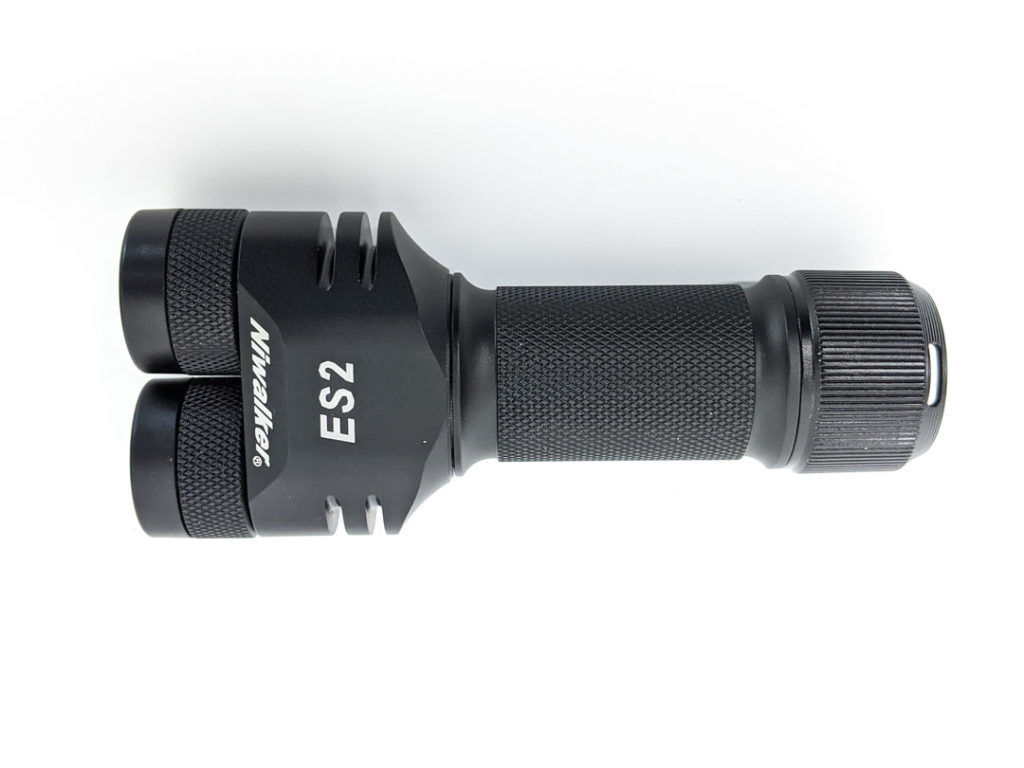
Specifications
| Brand/model | Niwalker ES2 |
|---|---|
| LED | Several: XPL-HI, XPL-HD, Triple XPL-HI, Triple Nichia 219B, Osram CSLNM1.TG Red, Osram CSLNM1.TG Green, Luminus SST20 Blue, Seoul Semiconductor UV |
| Max. lumens | 7050 Lm for XPL-Hi and XPL-HD |
| Beam intensity | 215m (equates approx 115 kcd) |
| Battery config. | 1*21700 |
| Material | Aluminum |
| Modes | 15 |
| Blinkies | Strobe, beacon, candle light, bicycle mode |
| Reflector | TIR optics |
| Waterproof | IPX8 |
| Review date | December 2020 |
INTRODUCTION:
For those who are familiar with Niwalker, you can skip the introduction !
Personally, I did not know anything about them. I once read about them on BLF, but didn’t know anything about the brand’s origin and history. That’s why I have looked it up for myself and for you!
Niwalker doesn’t really mention how long they exist, or anything about their history. But, they do tell they are owned by Technomate.
“ Technomate is a leading professional portable LED lighting tool manufacturer that integrates near a hundred R&D staff and a thousand workers and also owns the latest testing lab in the industry. Niwalker products are made with military standards, ideal for all kinds of outdoor activities, camping, hunting, diving, and cycling etc. We are committed to creating innovative products with maximum value for customers all over the world.”
One interesting fact is that Technomate actually does tell something about their history 🙂
“ Technomate is a manufacturing company that provides our clients with a broader view in LED portable lighting. Incorporated in 2001, we provide industrial design service, product development consultation and production to our customers.
Technomate is currently one of the biggest manufacturers of Aluminum LED flashlights in the industry. We design, manufacture, sell and export a wide range of portable lighting productions including flashlights, headlamps, lanterns, keychain flashlights, lighting gadgets, sporting items such as diving and cycling lights to the world.
Technomate serves customers globally. Both OEM and ODM customers are welcomed. We dedicate our best effort to be “Your One-Stop Portable Lighting Product Partner”.
At first, I thought this is some typical exaggerating seller’s story, but on their website, they show several images of their facility, which seems very impressive!
Package quality.
The package itself is not very fancy, it comes in a standard brown recycled cardboard box with an adhesive on it which tells you whats inside the box, but hey, most people just throw the packaging right into the garbage anyway! (except just us, the nerdy flashaholics)
Inside the box we find the light with double head, tube, O rings, lanyard manual
It does come with an additional package, which had the additional light heads in a nice hard plastic resealable case.
The fun factor of this light is that it has a double head and replaceable lights, just unscrew the head with pill and insert the desired light type you want!
- ES2 flashlight
- Spare o-rings
- Lanyard
- Manual
- 6 additional heads

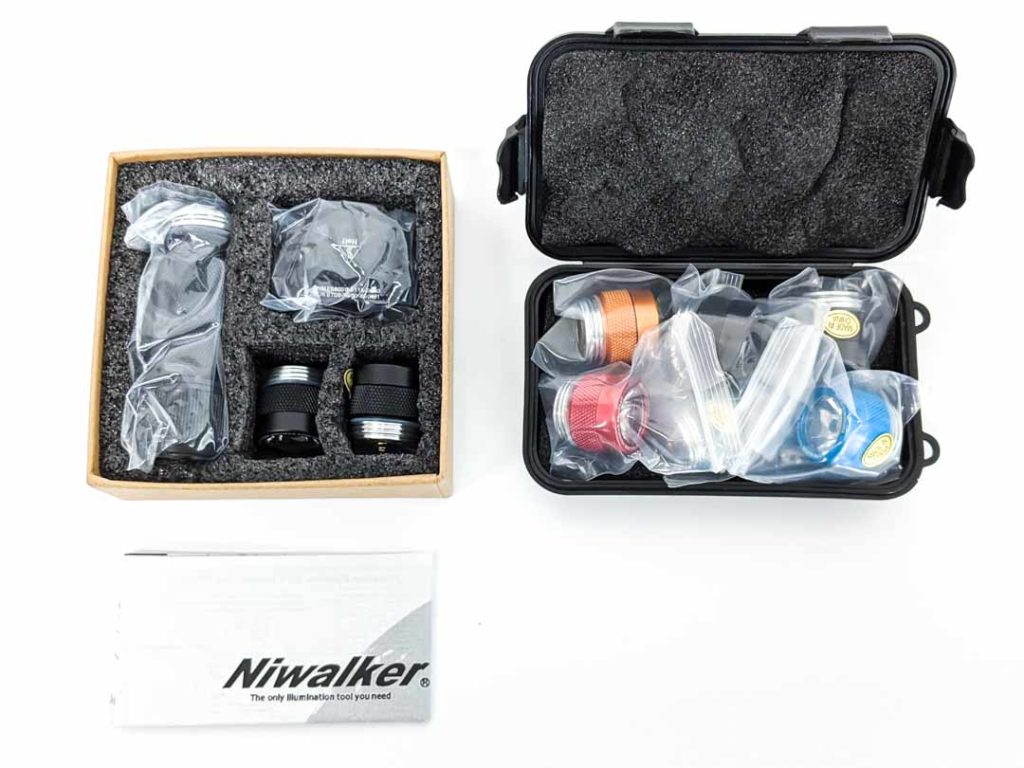
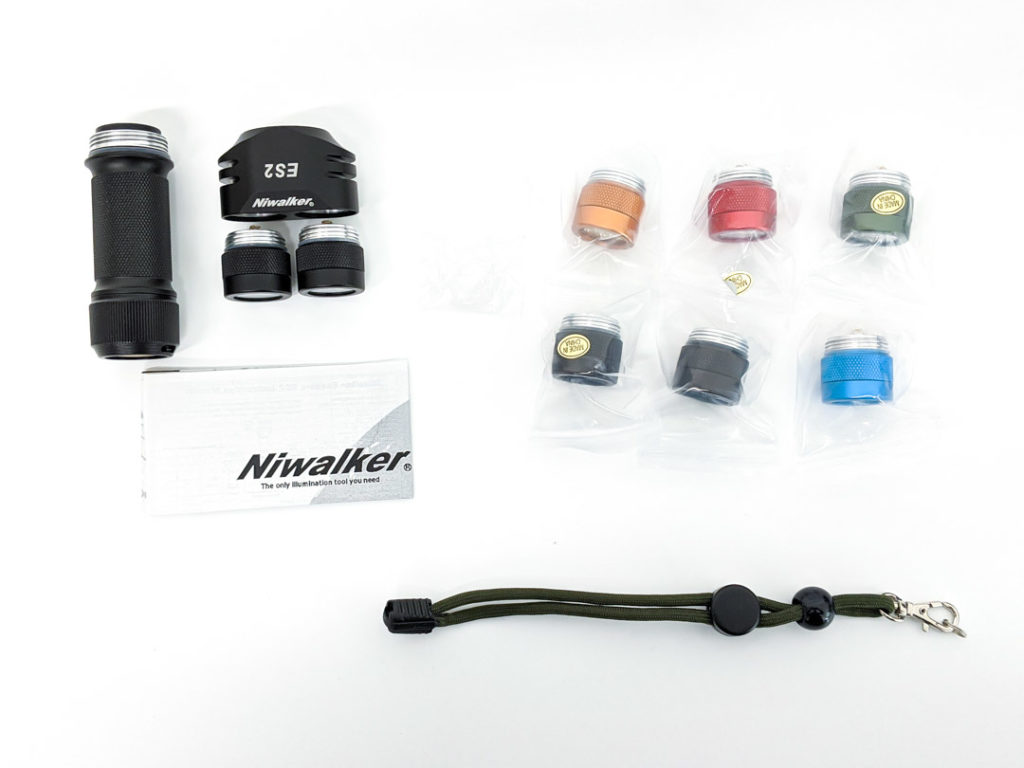
Handling of the light
My personal experience with the light: it doesn’t only look exceptional, it also feels exceptional.
Being fitted with a double head makes it a bit funny. It looks rather unusual, and the first time holding it, it also feels unusual. Most lights don’t come with a double-head, especially not ones that are exchangeable, being the priority and power of this light.
After a while you’ll get used to it and I was perfectly able to use this light, just like any other.
It provides enough grip due to the knurling. Being a 21700 light, it will guarantee a good firm grip within the palm of your hand. Albeit a bit front heavy due to the chunky head part and the double light head. Due to its size and weight, it’s certainly not easy to carry in your pockets, so it certainly won’t be my new EDC.
Its size, weight, and dimensions will prevent any rolling, and it’s able to tail stand, even with the lanyard attached to the tailcap. Operating the ES2 is very easy since it’s fitted with an E-switch in the tail of the light.
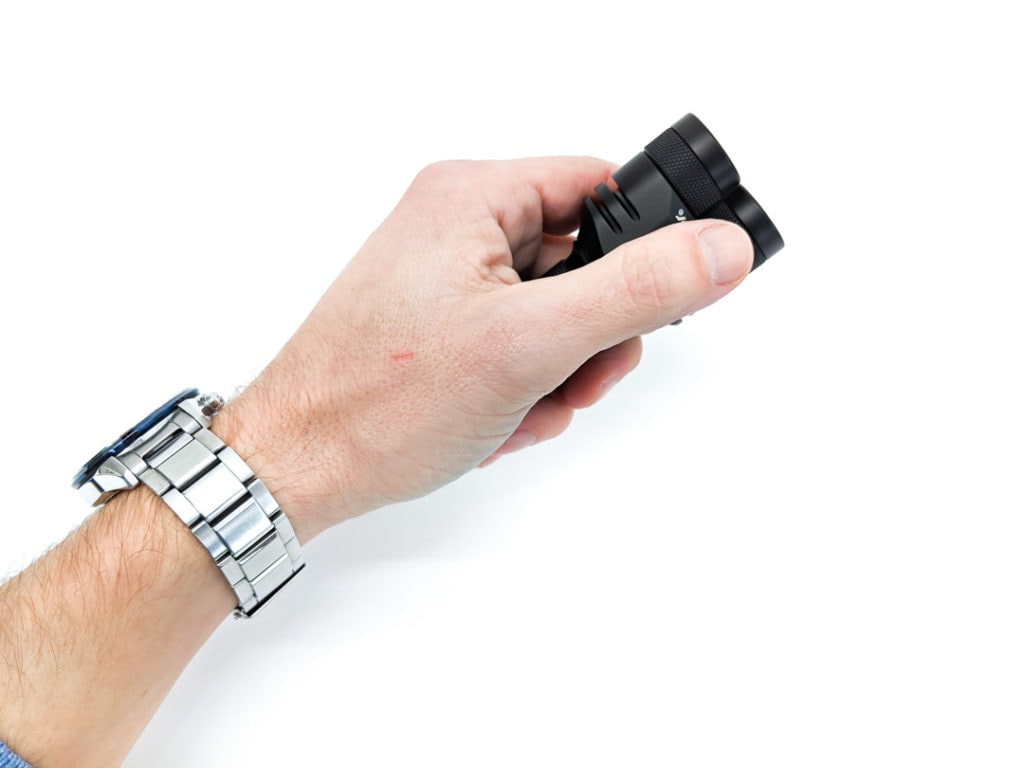
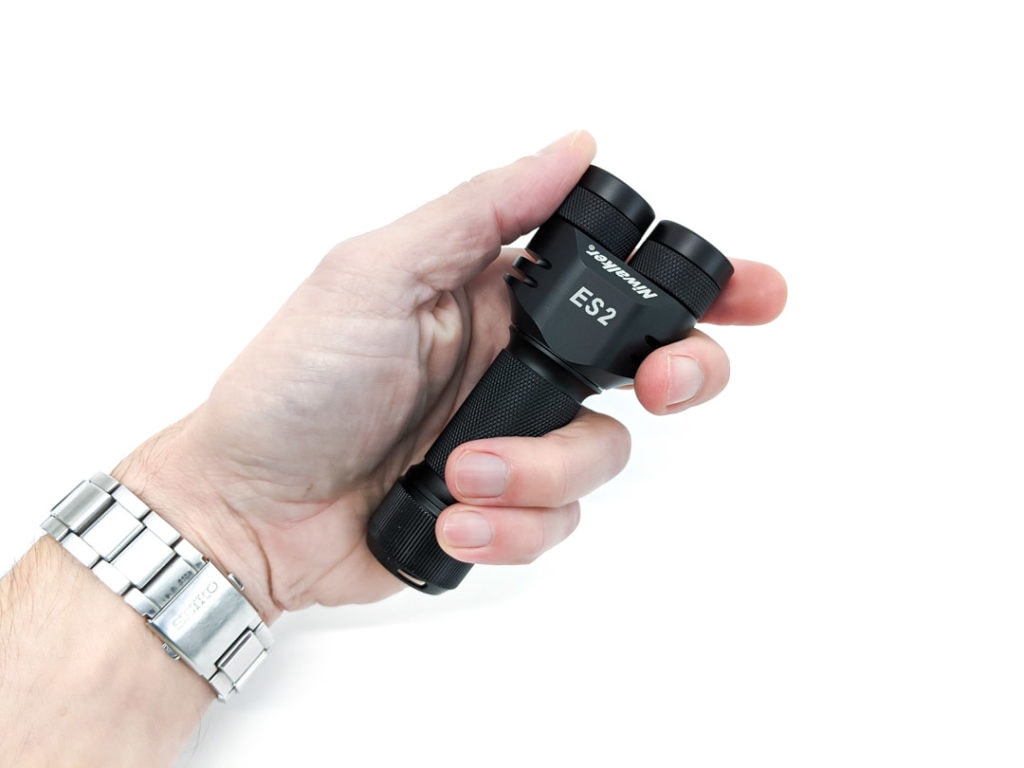
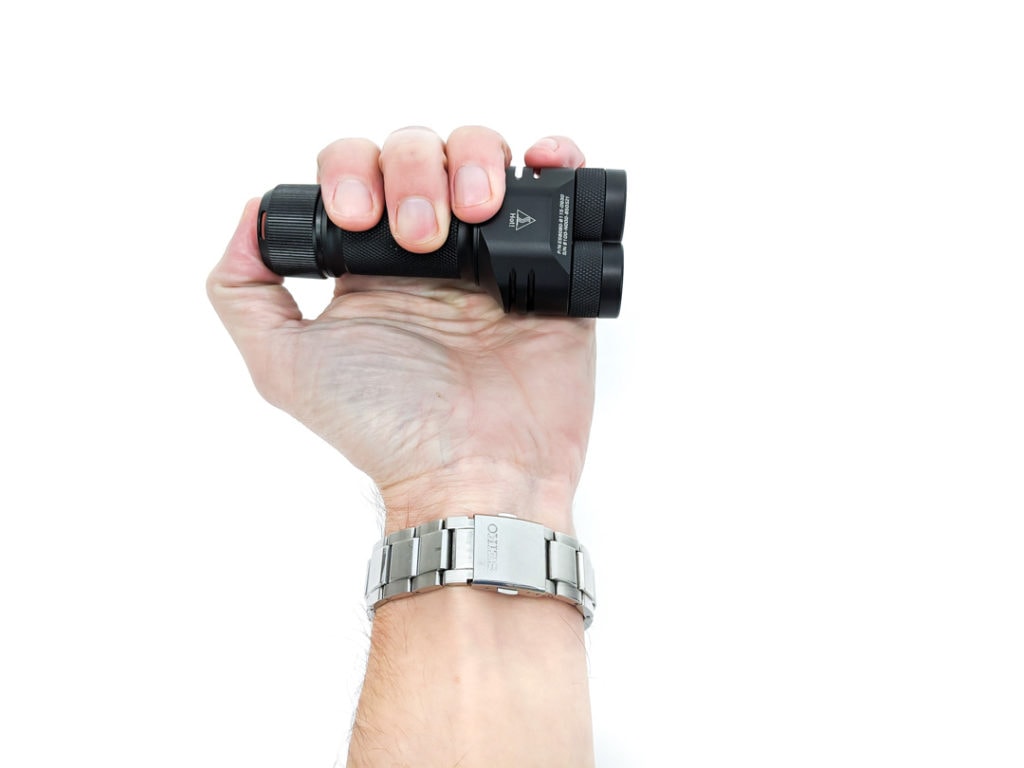
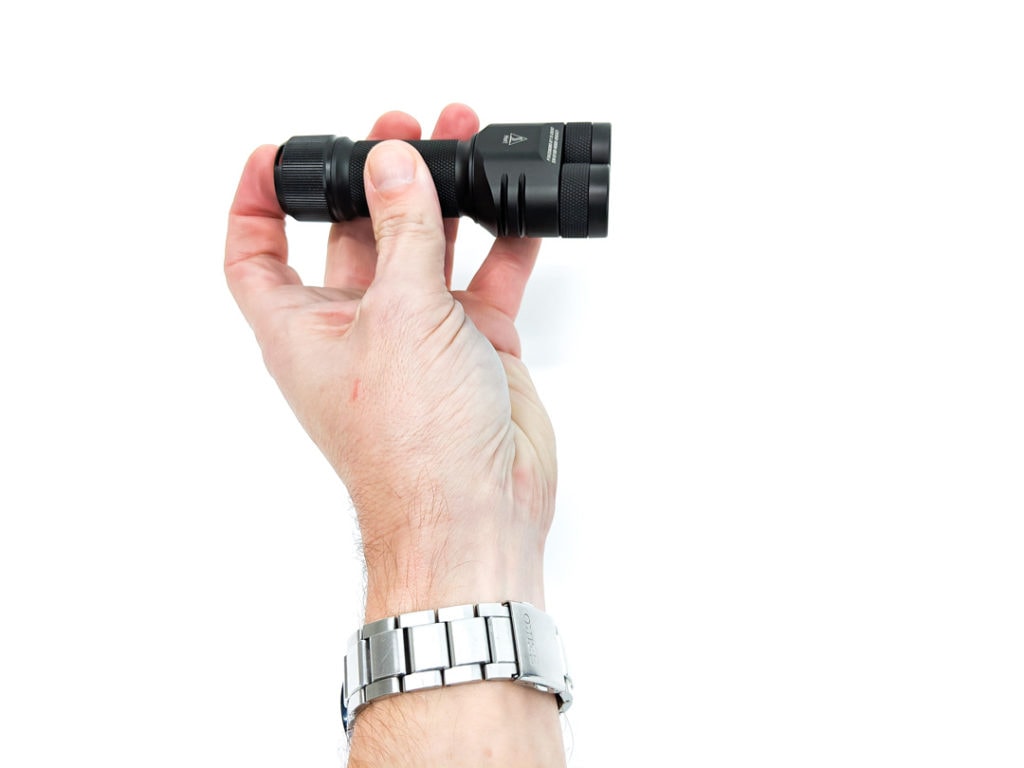
Build Quality, Knurling, Threads, and anodization
The build quality of this light seems to be decent, it’s made of aluminum and I could not find any defects or flaws.
The anodization is type HAIII and has a satin finish, but it’s a bit on the glossy side. The threads are decent as well and they’re quite durable, it seems to be rectangular cut.
Although I did find one O-ring was torn after unscrewing and tightening the battery tube a few times. Maybe this is something they need to improve?
I replaced the o-ring with the spare one that came with it, and even that one snapped after a few times of use. That shouldn’t be really happening, should it?
Another interesting fact is that the tailcap is fitted with an e switch, which looks to be screwed onto the battery tube. I was trying to loosen it but without any luck. Putting it in a vice with some protection ended up with a big scratch on the tailcap. It looks like it uses a thread locker, which shouldn’t be insurmountable though.
But it feels a bit unnatural to unscrew the whole battery tube instead of the tailcap, especially since it looks to be mounted with regular threads. After all, several other brands did succeed using the double tube which is necessary for an E-switch, with a proper tailcap.
For instance Emisar and Noctigon (with the KR1 and KR4), or Magicshine which even has built-in charging with their additional MAS C1 module, which is pretty great by the way)

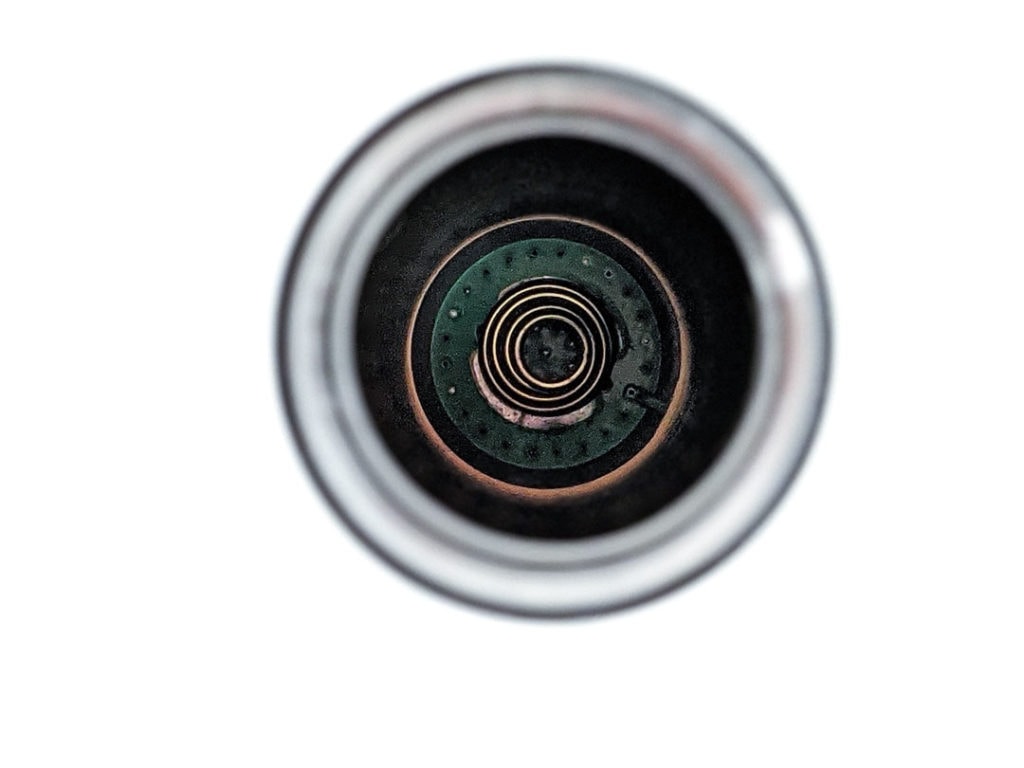
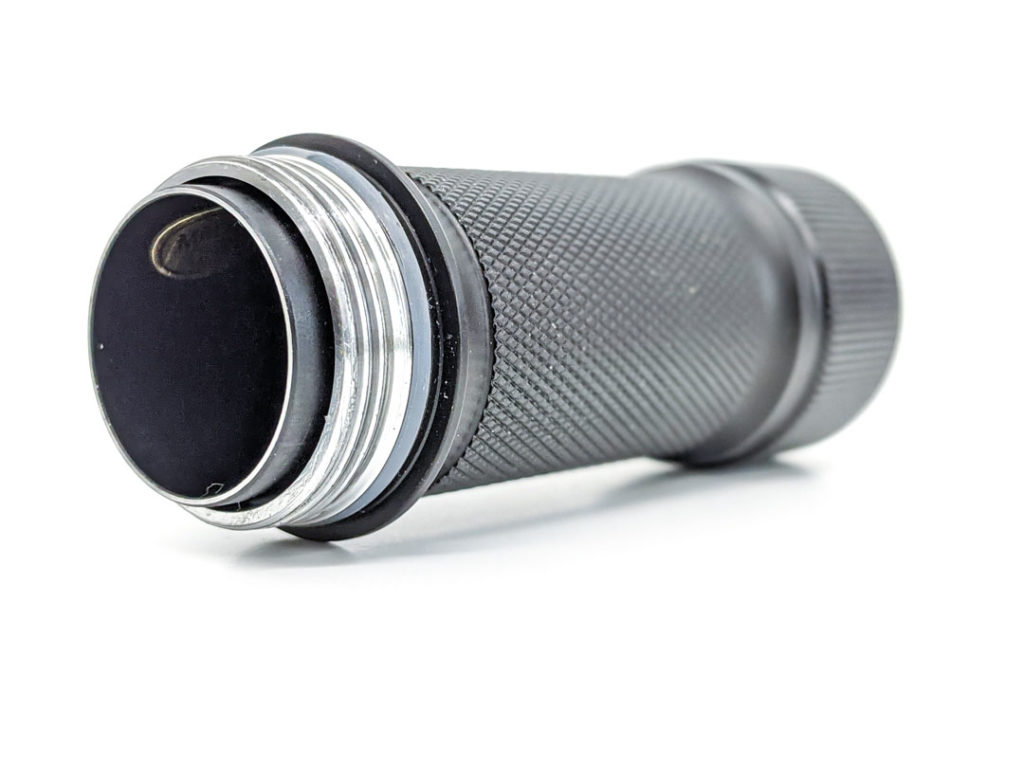
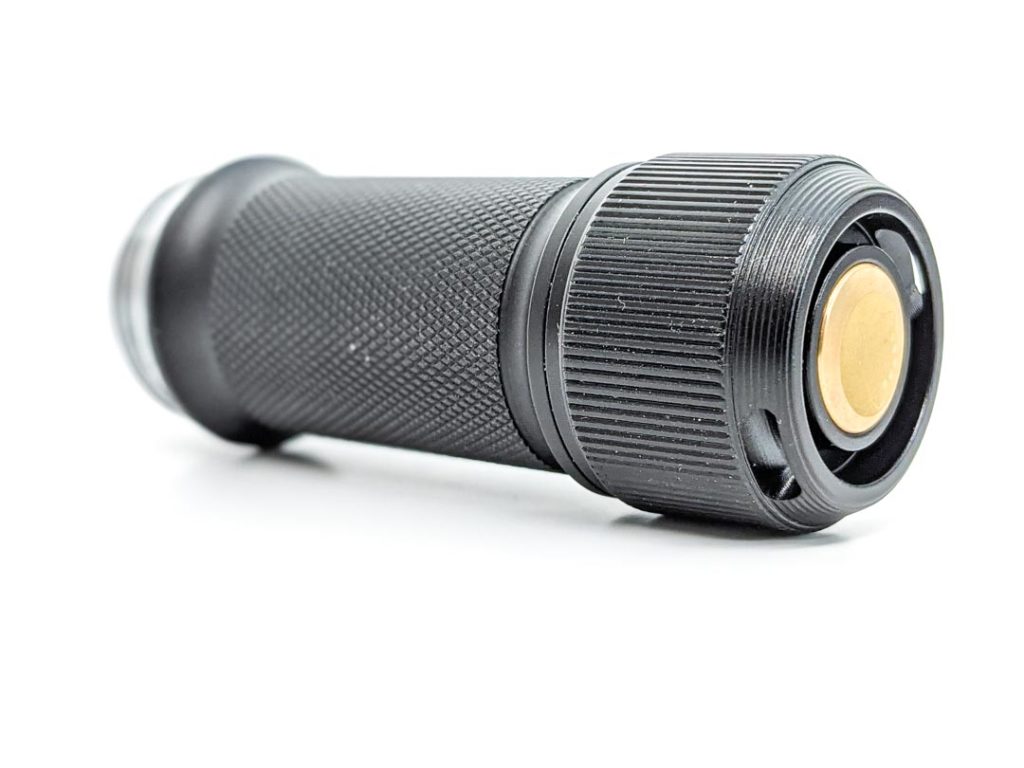
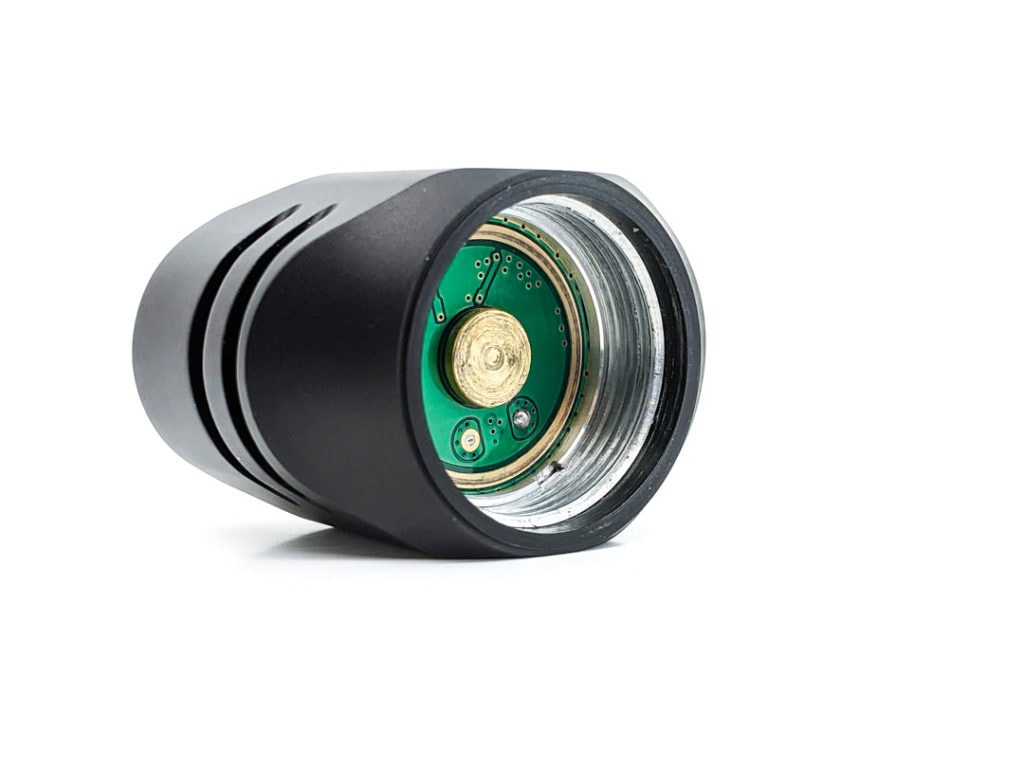
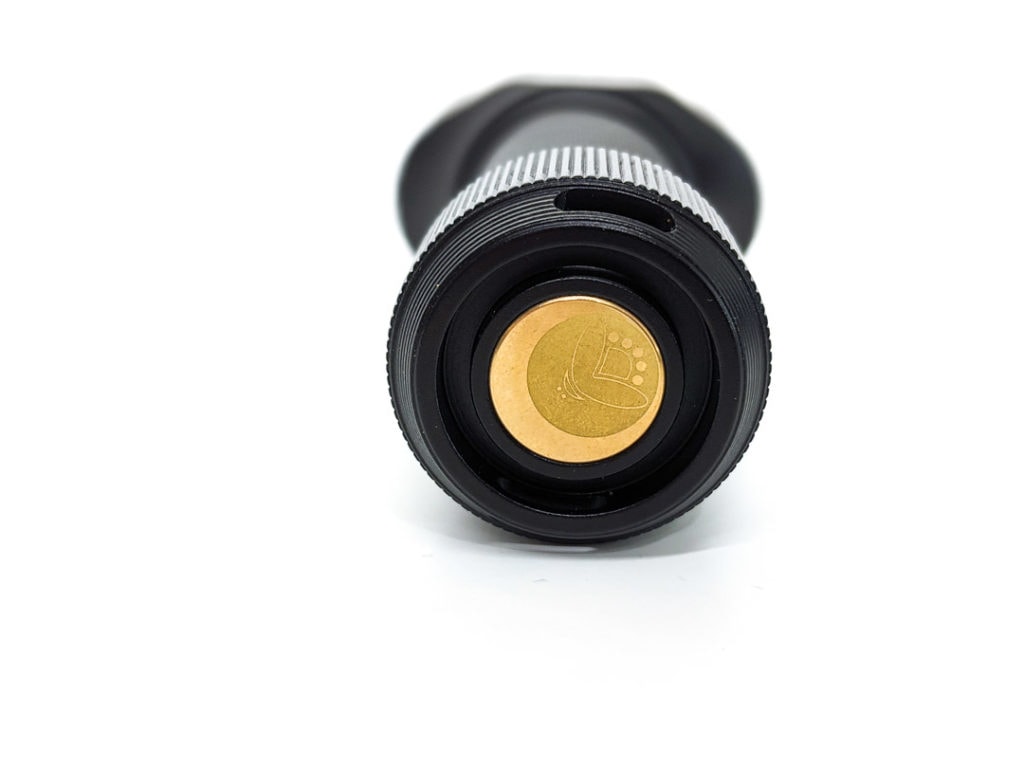
LEDS, LENS, BEZEL, AND REFLECTORS
All LEDs use TIR optics (Total Inner Reflection), even the single ones. The triples all seem to be fitted with Carclo triple optics type 10507, so they used good quality materials. They even used glow gaskets in the triples, that’s really cool!
Light sources that were included with this light are:
- XPL HD V6 CW (single)
- XPL Hi V3 NW
- XPL-HI, (triple)
- Nichia 219B (triple)
- Luminus SST20 Blue (single)
- Osram CSLNM1.TG Green 1890 Lm, 145 Min, 439 meters , 48180 Cd (single 1050 Lm)
- Osram CSLNM1.TG RED 215Lm, 150 Min, 211 meters, 11130 Cd (single 150Lm)
- Seoul UV 365 nm (Triple 3x 3W)
All heads look great. They are made entirely of aluminum and have a flush head without any crenelations. The lower portion of the head is finished with diamond-shaped knurling, and all have square-shaped threads. The heads can be disassembled easily by unscrewing the two parts, so for real flashlight enthusiast, you can even mod them!
A transparent silicone O-ring is used on every head to ensure the IPX8 rating.
The picture with all heads side by side shows that not all are identical, some heads are fitted with a spring for the positive terminal connection, while others use a flat electrical connection with the mating part of the light. I did not figure out yet why there is this difference.
The beam of each head is very comparable since they share the same optics. The single emitters clearly throw farther than the triples, which give a more floody beam.
A slight difference can be perceived, which underlies the fact that each LED has different characteristics, such as composition, but mainly its size is the culprit.
LEDs with smaller dies always throw farther, but the drawback of a smaller LED is that it simply cannot generate the amount of light of a larger one.
As shown in the beamshots, the Osram red and green have smaller dies, and throw farther. XPL HI throws pretty good as well, but there is an obvious difference.
The XPL HD throws a bit less far and is a more floody beam. The famous Nichia 219B head throws less far because it’s a triple, but has fantastic color rendering. Therefore it’s difficult to give any recommendations for getting the best flashlight since each has its own characteristic.
Pictures and videos usually give the best idea about the beam pattern, especially with comparison shots.
Fun fact, when you use the basic RGB primary colors, you can always combine two. I ended up with a purple beam, using the red and blue LEDs.
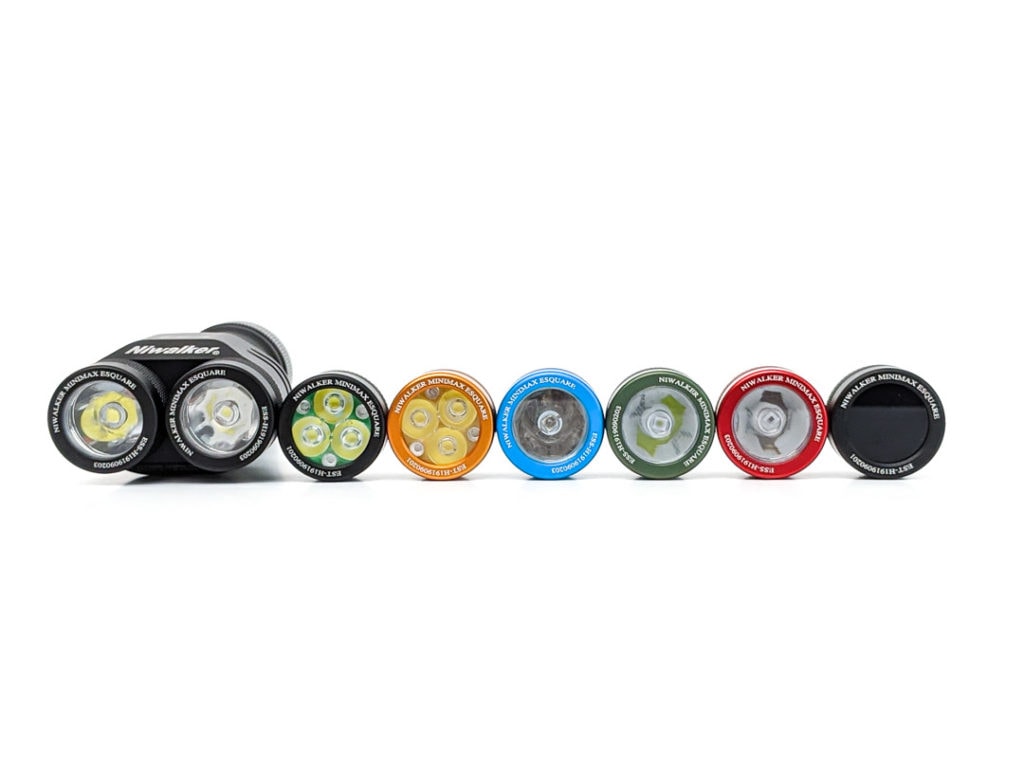

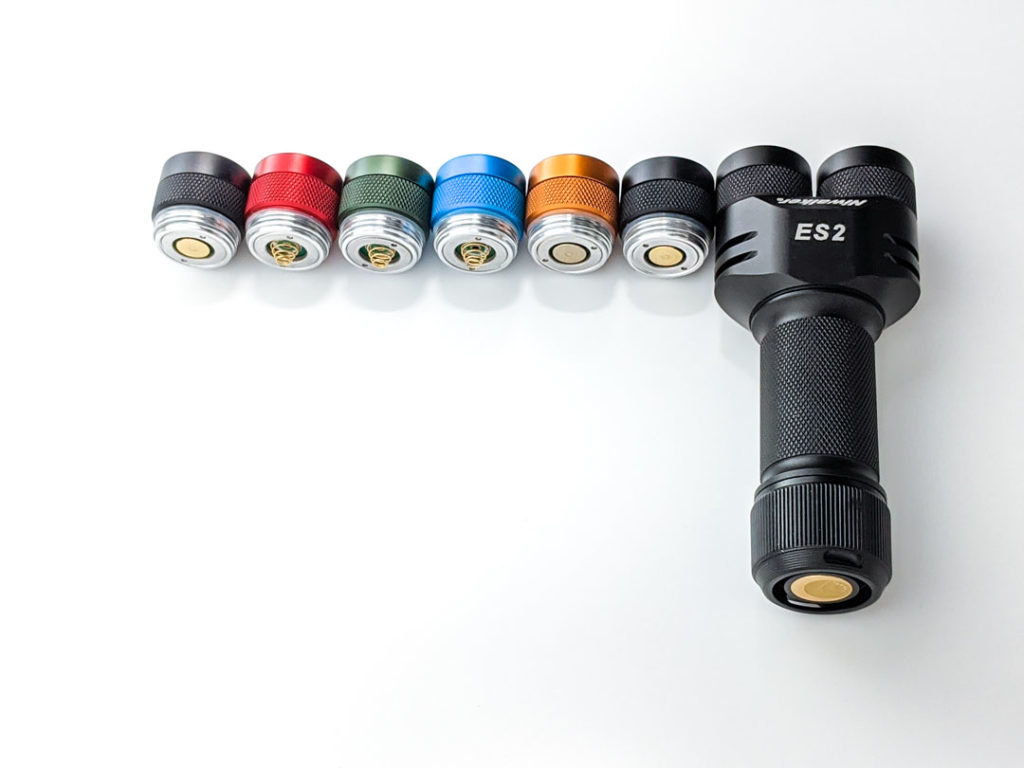
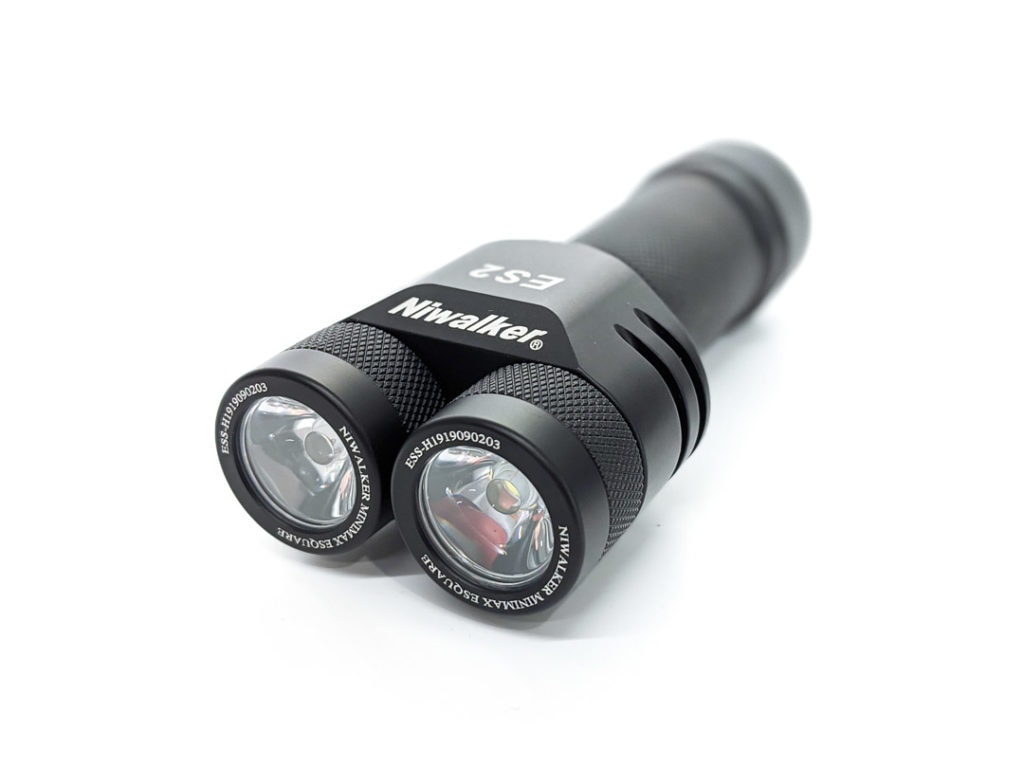
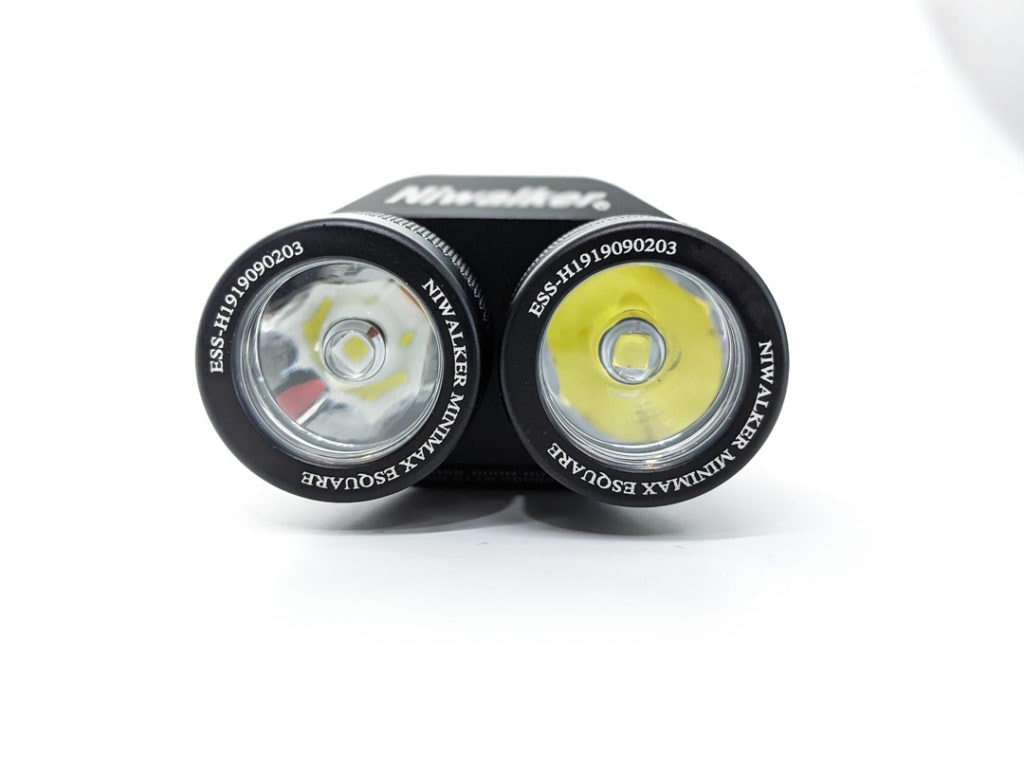
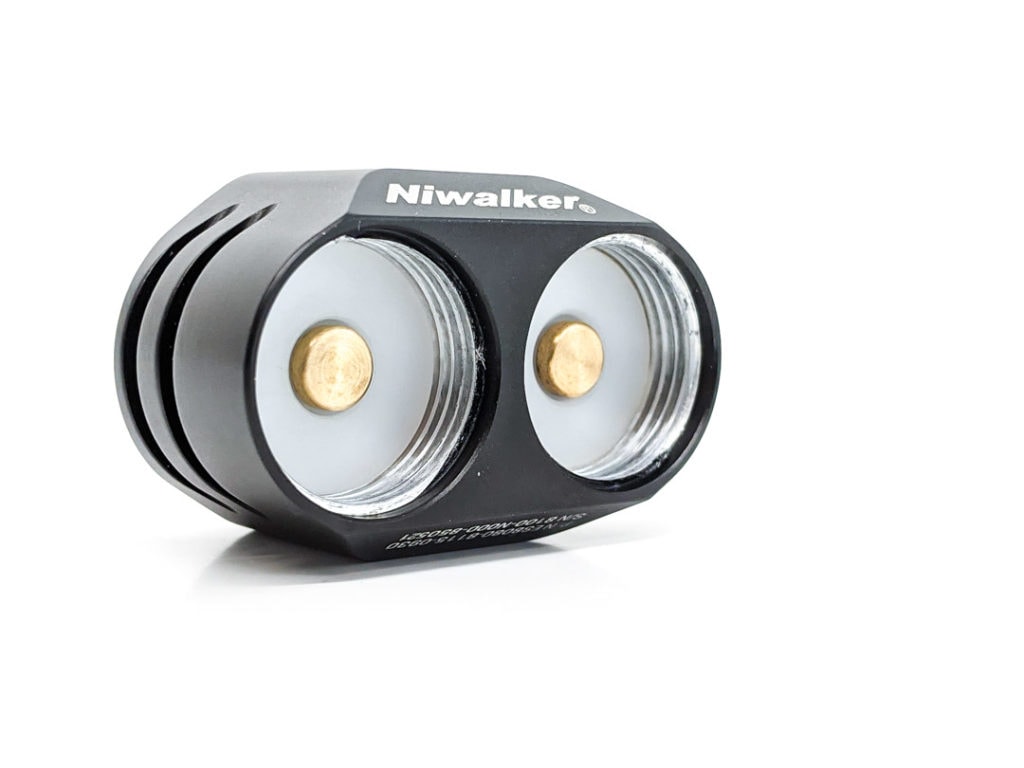
Dimensions
- Length: 119mm
- Head diameter: 51mm x 33 mm
- Body diameter: 27.8 mm
- tailcap diameter 31.5 mm
- exchangeable head size diameter 25 mm x 24 mm height
Weight:
- Without cells: 151 grams / 5.60z
- With cells: depends on the battery, with a Samsung 21700 40T it is: 151gr +67 gr =218 grams
Popular FlashlightS compared
Size compared to some of the current most popular flashlights.
From left to right: Convoy S2+, Niwalker ES2, Amutorch XT45, Thorfire BLF Q8, Convoy C8, Astrolux FT03.
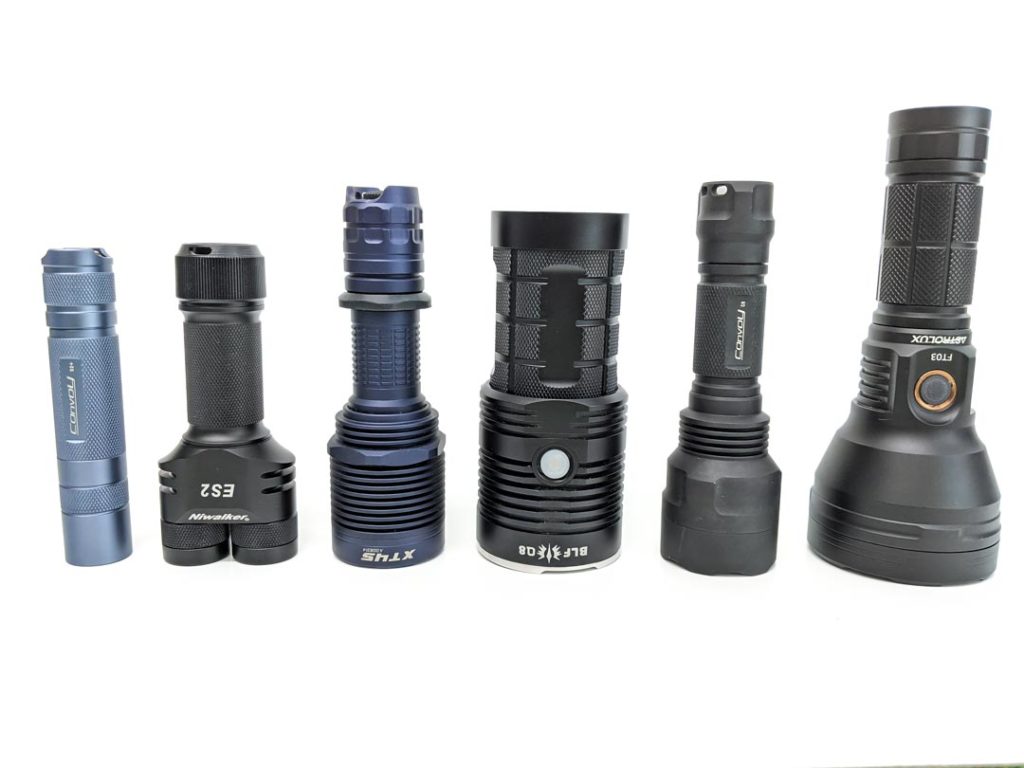
Driver & User Interface:
The Niwalker ES2 uses a custom firmware, that looks and feels a lot like the Anduril firmware.
There are several options you can choose from. Such as stepped ramping or smooth ramping, momentary mode, strobe mode, mode memory + many more, and you can use 2 heads simultaneously or select a single head.
Modes:
From OFF:
- Press and Hold: both heads start in lof (firefly they call it but it’s too bright for firefly)
- Single-click: last used memory
- Double click: Turbo (both heads)
- Triple-click: battery check
- 4 clicks: lockout (another 4x to unlock)
- under lockout there is a sort of momentary function, when the pwr button is operated the light will switch on for 1 sec after releasing the pwr button
- 5x click: True momentary (they call it tactical for morse and sos)to get out, manual sais remove tube/battery (?)
- 6x click: flash alternatively, some sort of alternating strobe (strobe left alternates with strobe in right head, quite funny.
From ON:
- Press and Hold: Ramp up (to ramp down release the button and hold until preferred brightness is reached)
- Single-click: switch off
- Double -click: Turbo
- Triple-click: NA (convert from stepped ramping to smooth and vice versa
- 4 clicks: NA
- 5 clicks NA
- 6 clicks flash alternatively
To select the use of a single head or dual head, double click and hold the switch pressed. Now you can select the preferred heads left right or both. The flashlight lights up left, then right then both and so on. Note: timing is crucial! At first I didnt succeed to switch between heads, but correct timing seems crucial.
Turbo is accessible by double click from all modes
Special Mode (blinkies)
- After 3 clicks for battery voltage check, double click to change to different modes, bicycle, candle light, signal tower, and strobe mode. (double click to select next special mode, a single-click will go back to regular mode)
Low voltage warning:
- Flashes 5x every 30 seconds when the battery is below 20% (20% from what? I found it discharged my 40T cells quite far, as far as 2.6V ,which is way too low in my opinion)
Strobe/blinkies
Niwalker calls these modes Special Modes, (I just call them blinkies)
- After 3 clicks for battery voltage check, double click to change to different modes, bicycle, candle light, signal tower (some sort of beacon, like used on s lighthouse) , and strobe mode. (double click to select next special mode, 1 click will go to regular mode)
Lock-out mode:
- It features a lock-out mode, which is accessible by 4 clicks (another 4 to unlock) .
PWM
- The light does not show any signs of PWM
Batteries & Charging
There is no battery supplied with the Niwalker ES2, but it can take almost every 21700 cell. I have tested lights where only smaller 21700 cells would fit, but this one even takes rewrapped cells and long cells.
I would recommend getting a good 21700 battery charger.
For instance, the Shocklii 21700 4500 mAh (purple) battery fits just fine. I only tested it with flattop cells, but since there is a spring on the bottom end, button top cells should work as well.
Performance
I measured Lux readings with a UNI-T UT 383 S lux meter, all tests are carried out with a Samsung INR21700-40T 4000mAh – 35A cell.
Amp measurement
Since the light uses a double tube for the E-switch and the tailcap is glued to the tube, I was not able to perform current measurements on this light.
Runtime graph
Each head is tested on a fresh charged Samsung 40T cell. What is interesting to see here is that the triples really show another behavior, which looks like thermal throttling. Probably they can’t handle the heat and the electronics regulate them, so they step down. All other singles really show a smooth curve, which indicates they run until the battery drains.
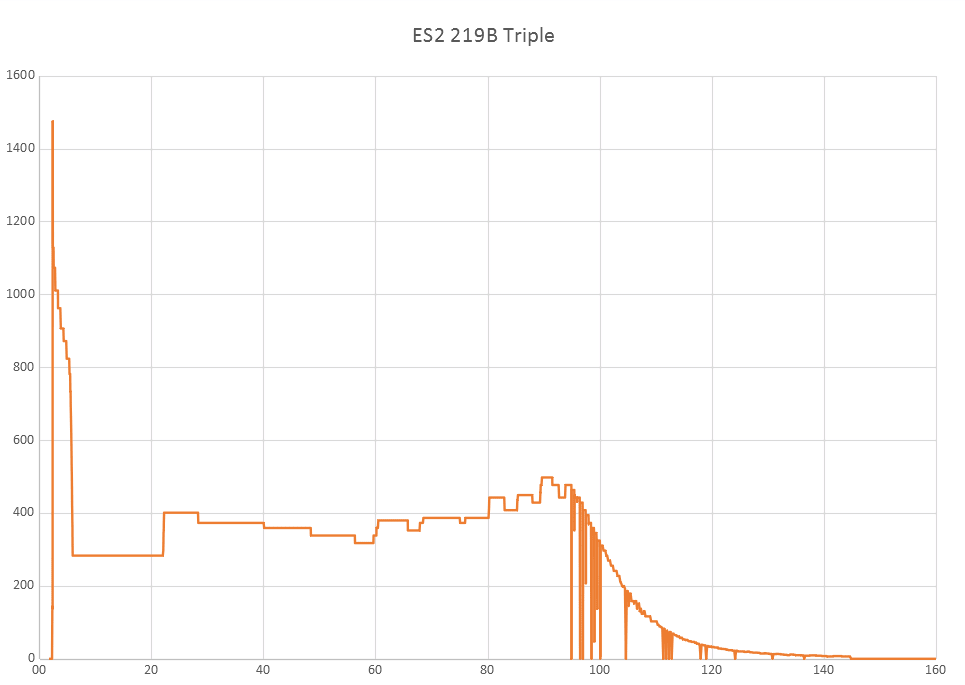
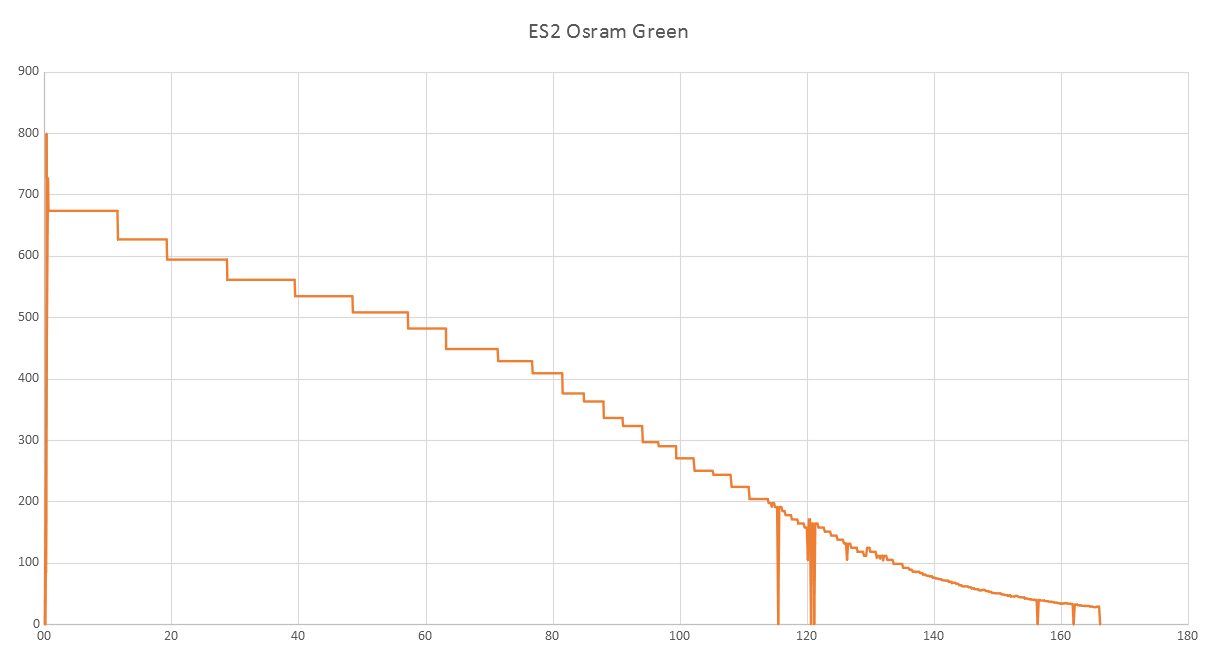
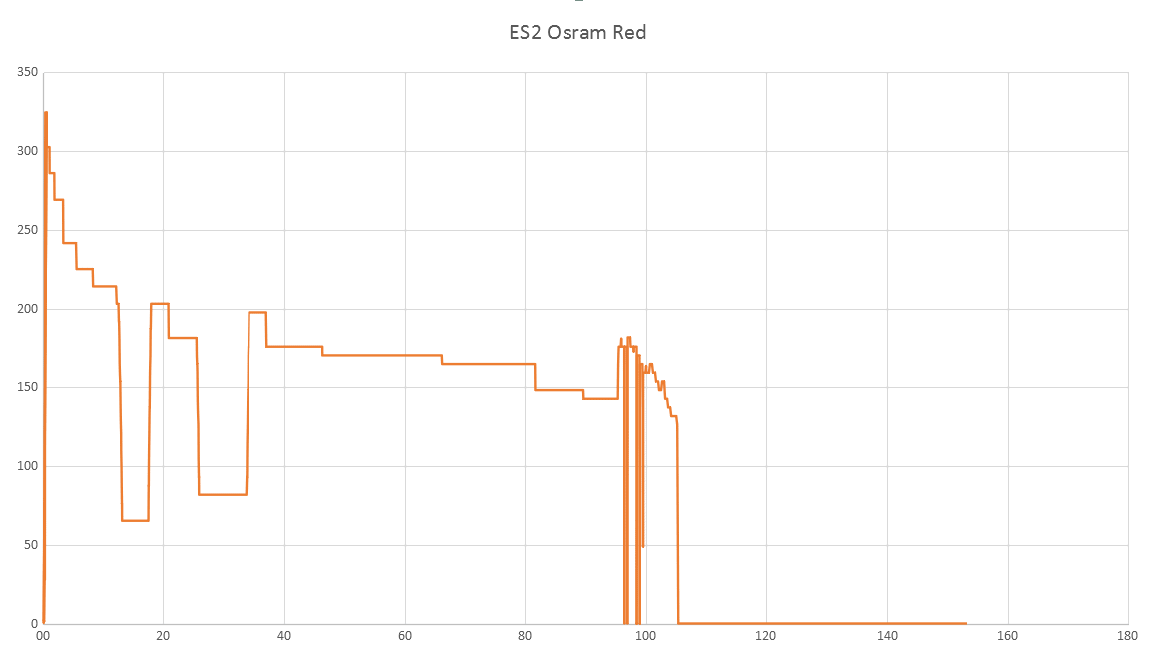
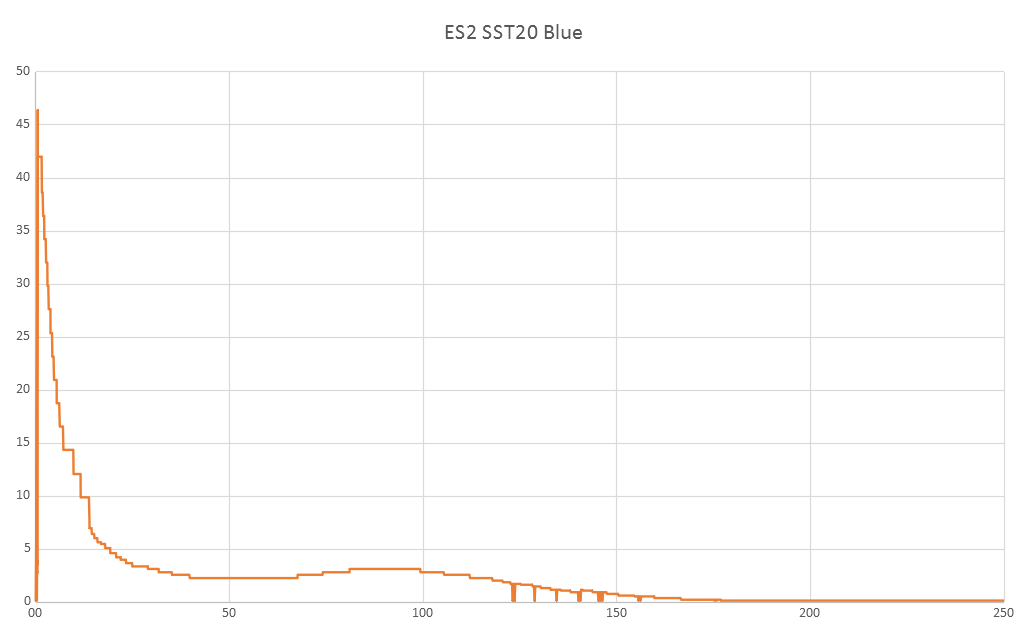
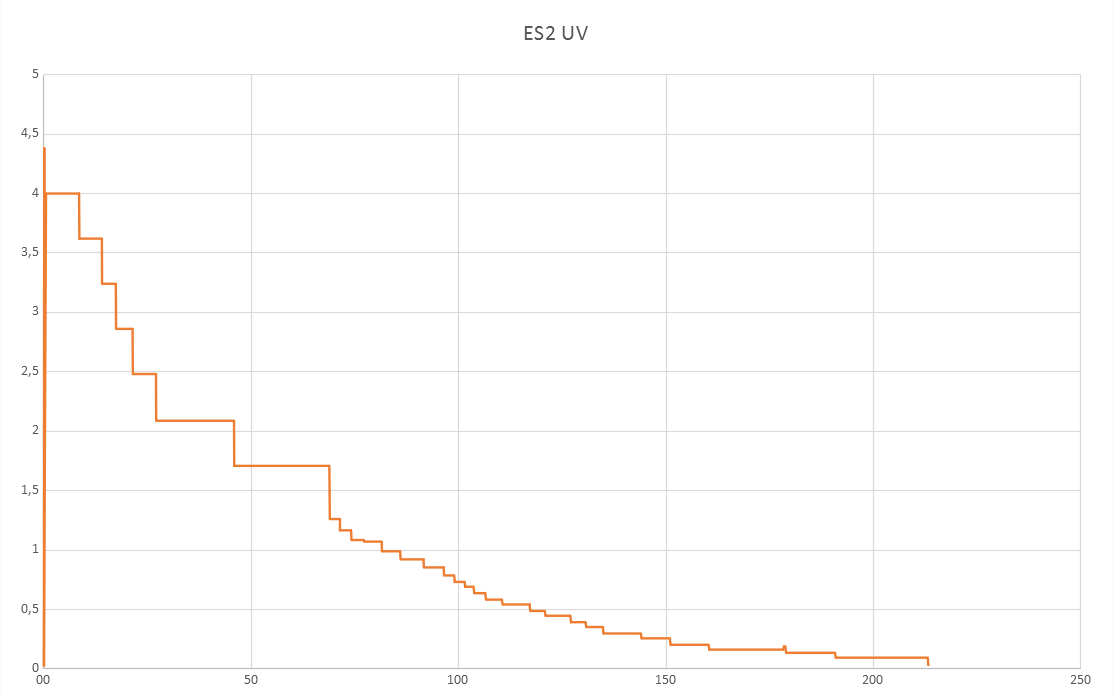
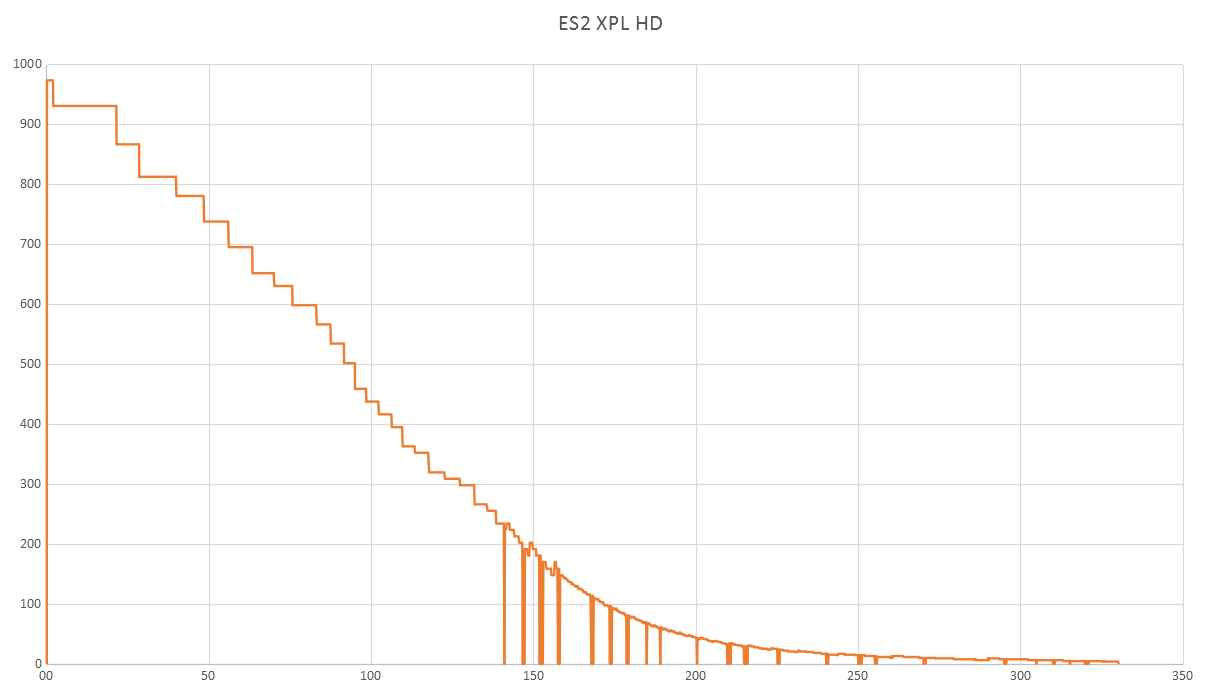
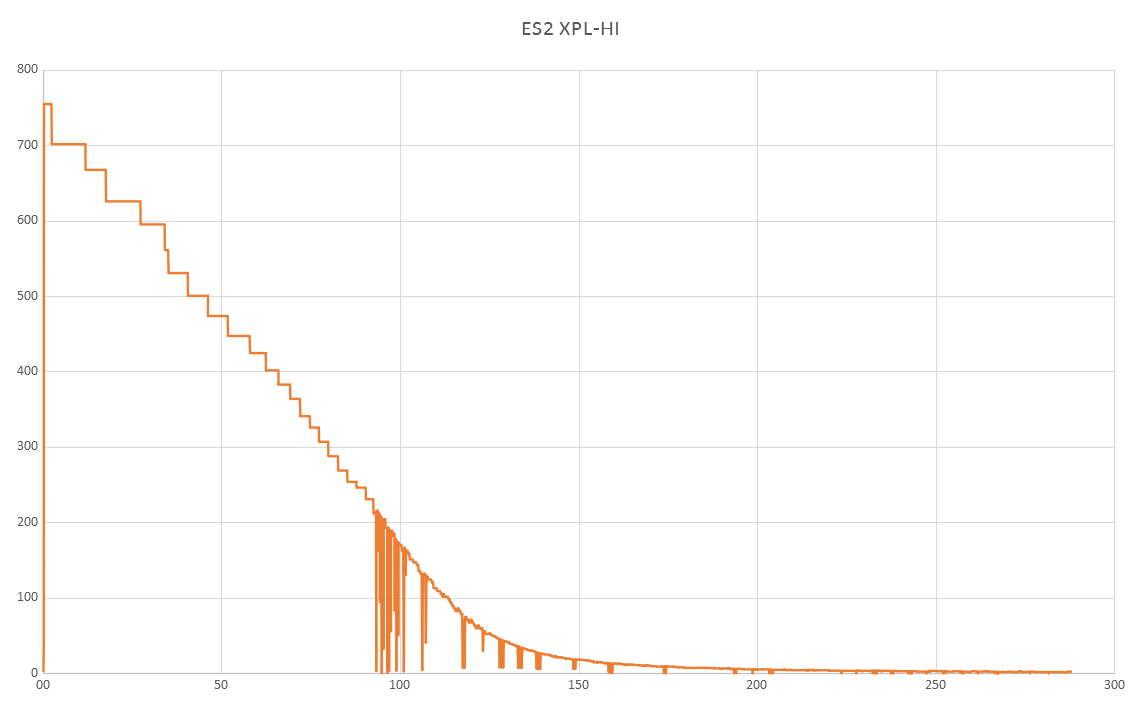
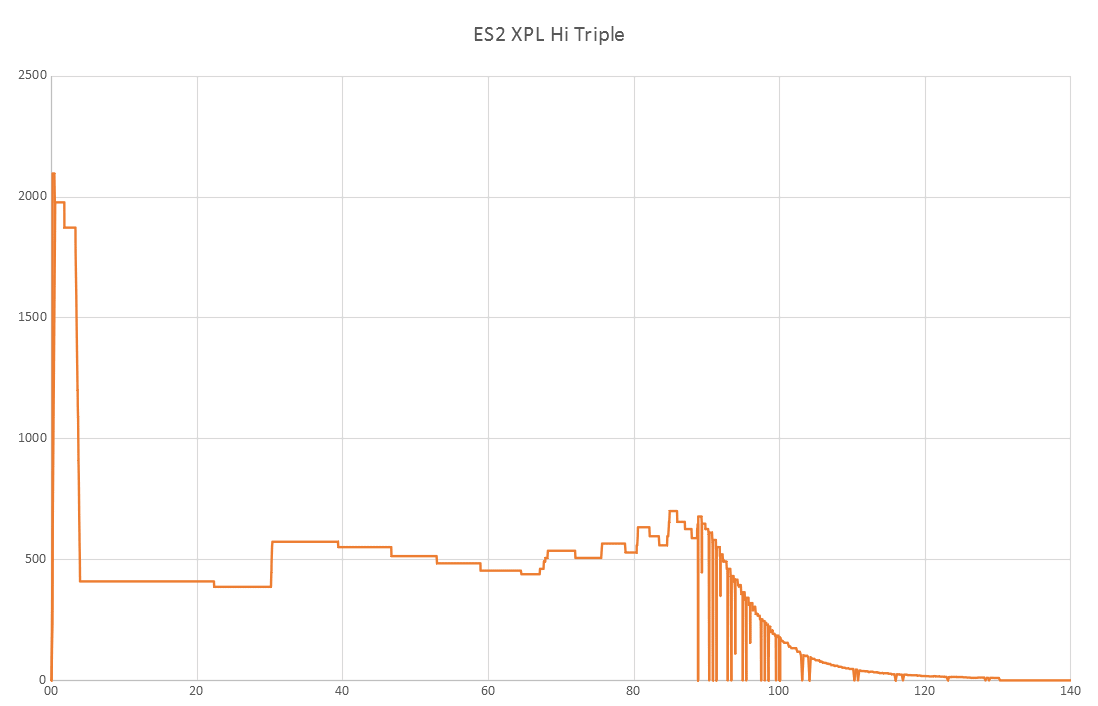
Lumen measurements (for each mode)
For the Lumen/runtime results, I am using an integrating Lumen tube which is not officially calibrated. However it is calibrated against one of BLF member Maukka’s officially calibrated lights, so it will give a very good indication, but for error a safety margin of 10% should be taken into account.
| XPL HD V6 CW (single) | 755 Lm |
| XPL Hi V3 NW | 974 Lm |
| XPL-HI, (triple) | 1978 Lm |
| Nichia 219B (triple) | 1476 Lm |
| Luminus SST20 Blue (single) | 42 Lm |
| Osram CSLNM1.TG Green | 727 Lm |
| Osram CSLNM1.TG RED | 325 Lm |
| Seoul UV 365 nm (Triple 3x 3W) | 4 Lm |
Throw numbers:
Throw is measured at exactly 5 m, with a UT-383-S Lux meter
| TYPE | Output (Lm) | Lux @ 5m | Throw (Cd) |
| XPL HD V6 CW | 755 Lm | 357 | 8925 cd |
| XPL Hi V3 NW | 974 Lm | 609 | 15225 cd |
| XPL-HI, (triple) | 1978 Lm | 484 | 12100 cd |
| Nichia 219B (triple) | 1476 Lm | 218 | 5450 cd |
| Luminus SST20 Blue | 42 Lm | 43 | 1075 cd |
| Osram CSLNM1.TG Green | 727 Lm | 1383 | 34575 cd |
| Osram CSLNM1.TG RED | 325 Lm | 397 | 9925 cd |
| Seoul UV 365 nm | 4 Lm | NA | NA |
Beamshots
I took the beamshots at an open field with trees near the end and a small ditch. This is approximately 400 meters, according to Google Maps. A fun fact, I had no trouble doing beamshots, except for the BLF GT90. When I powered the BLF GT90 up, I just saw the shape of the beam surrounded by fog (even an owl was distracted by it, and it flew towards me until it noticed me)
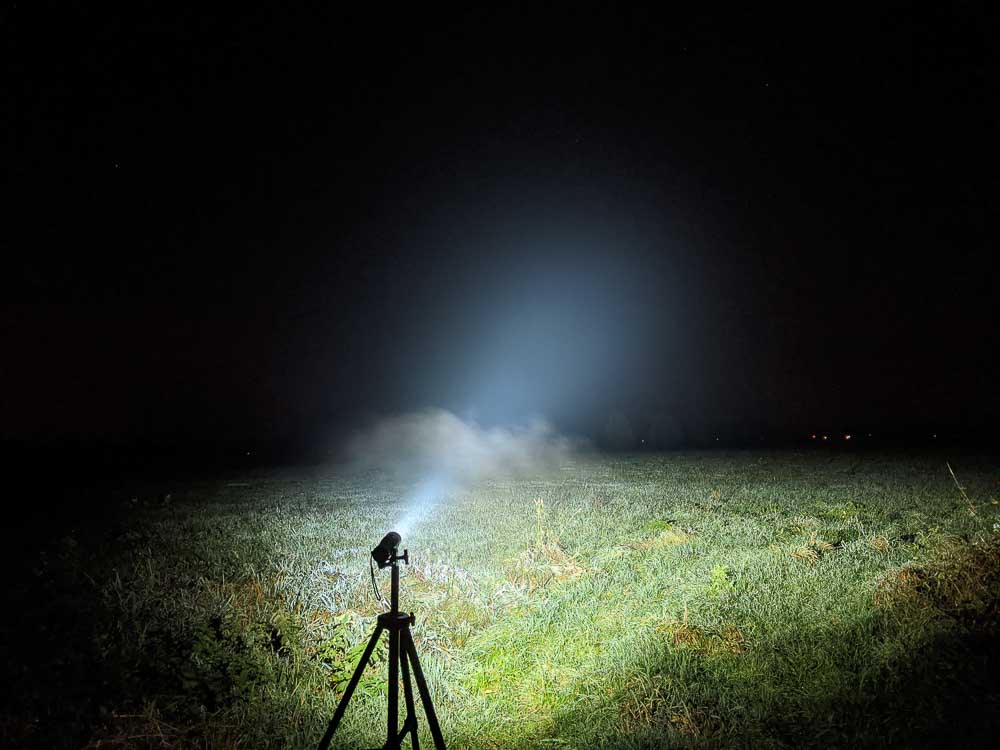
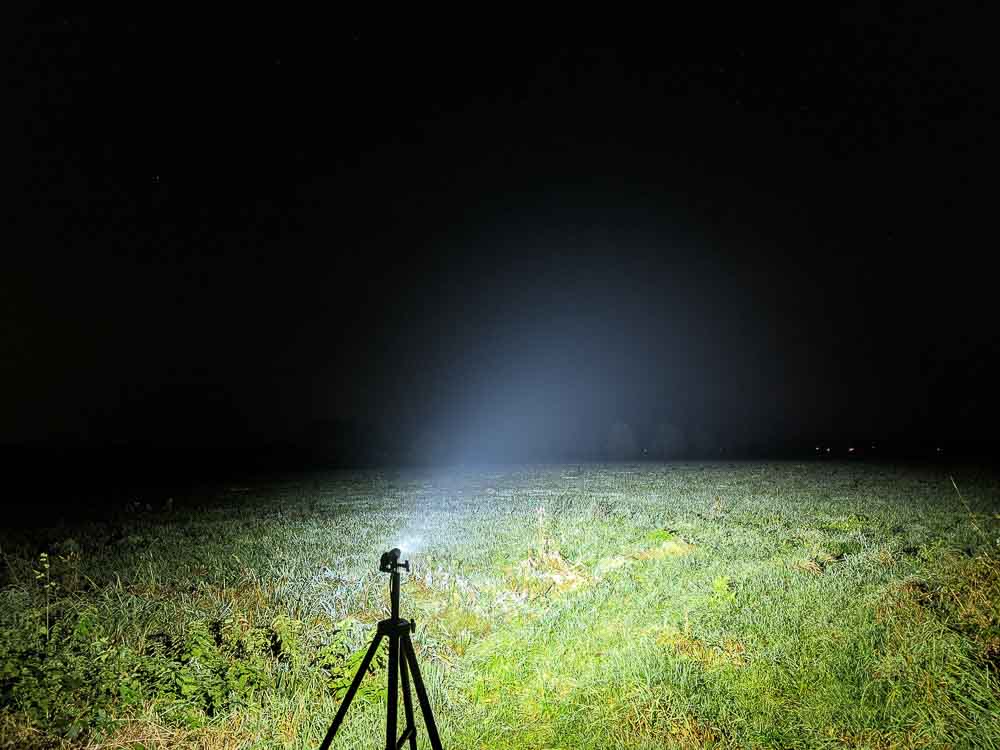
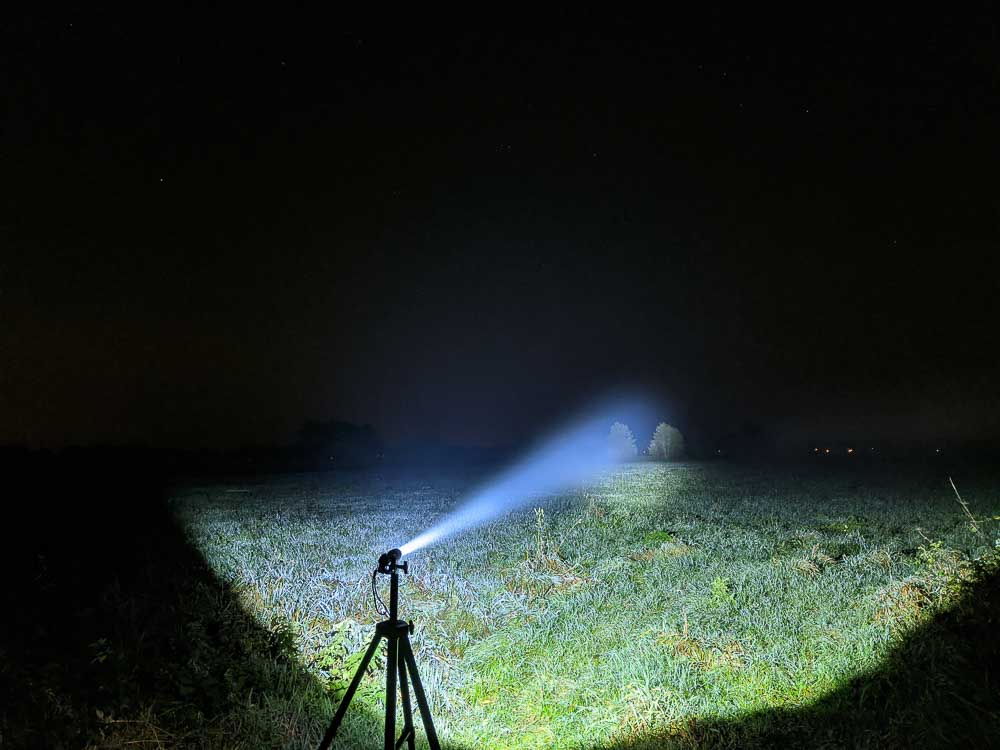
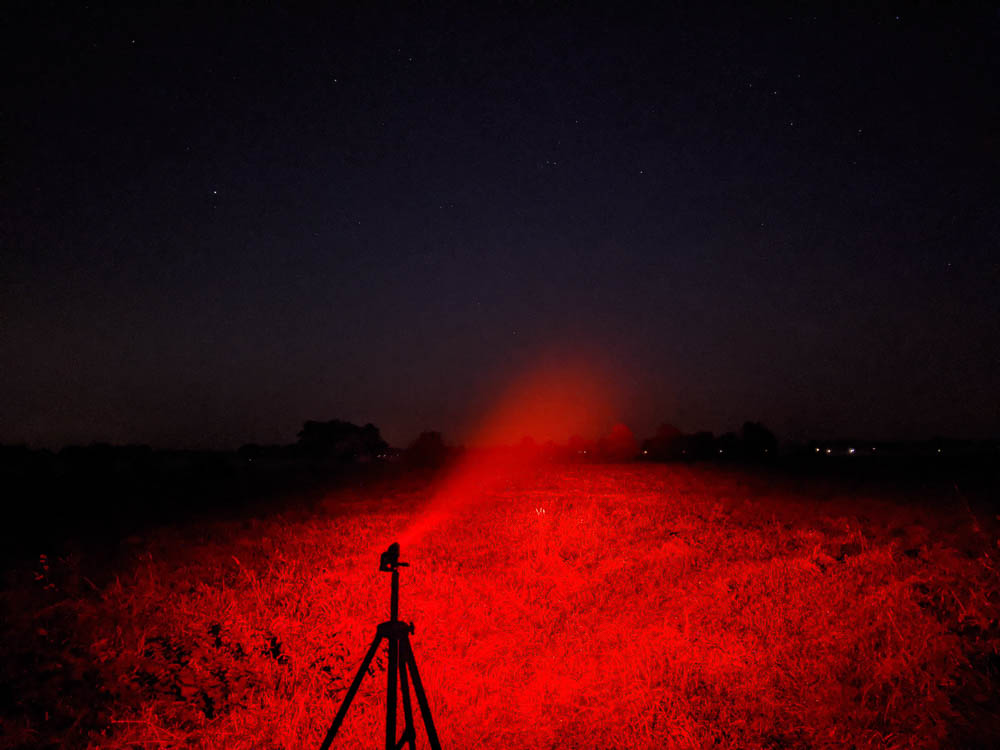


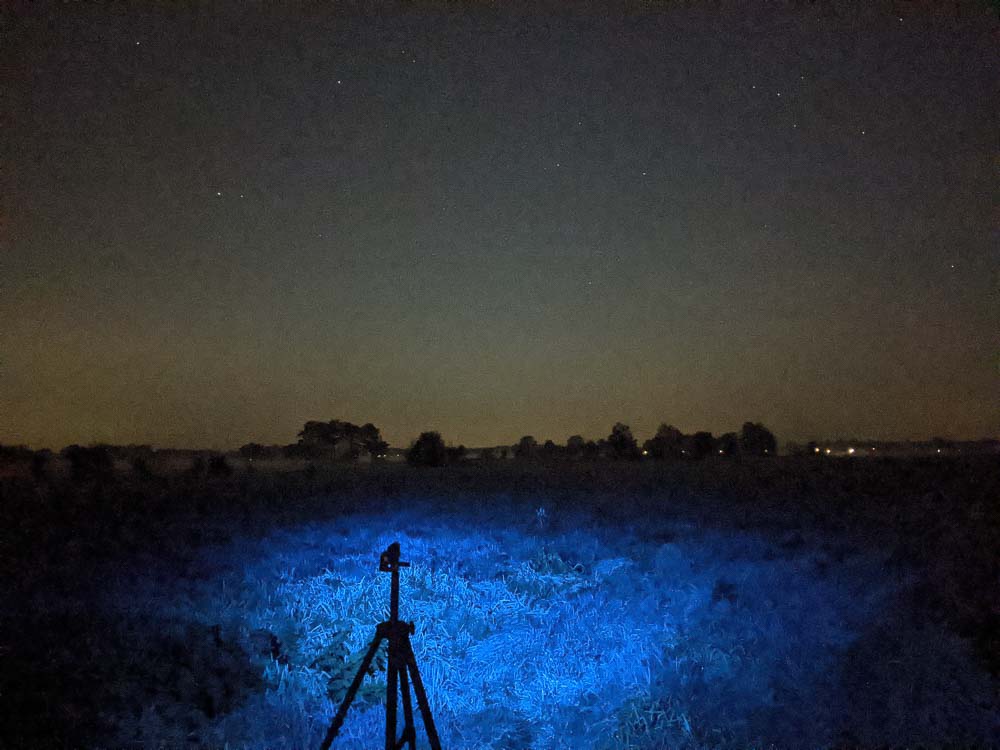
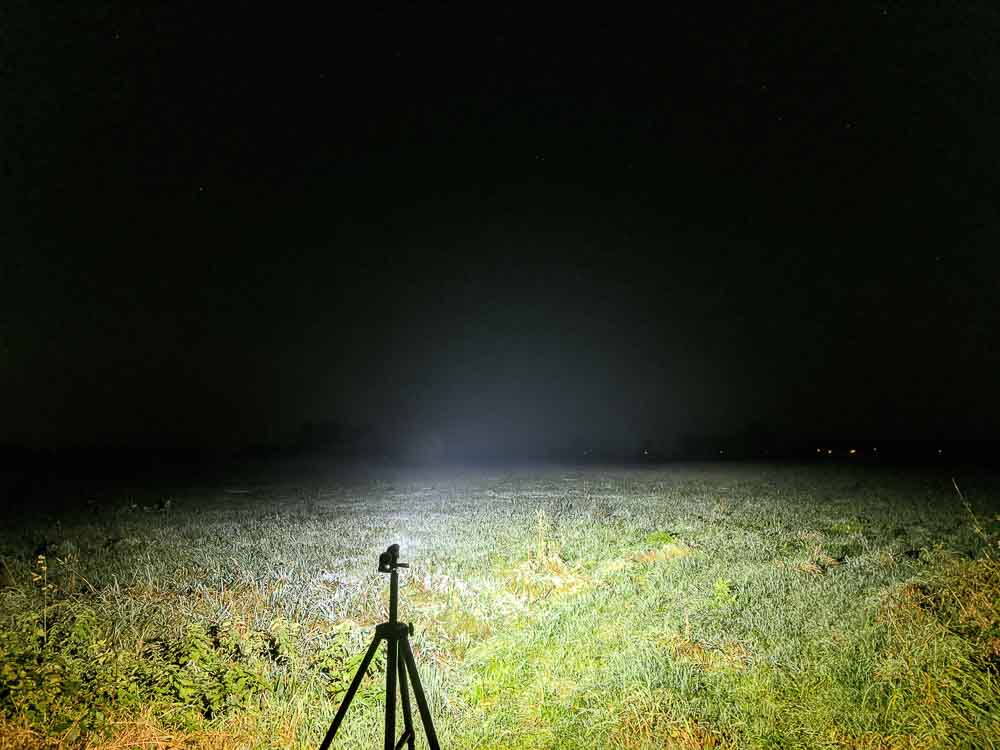
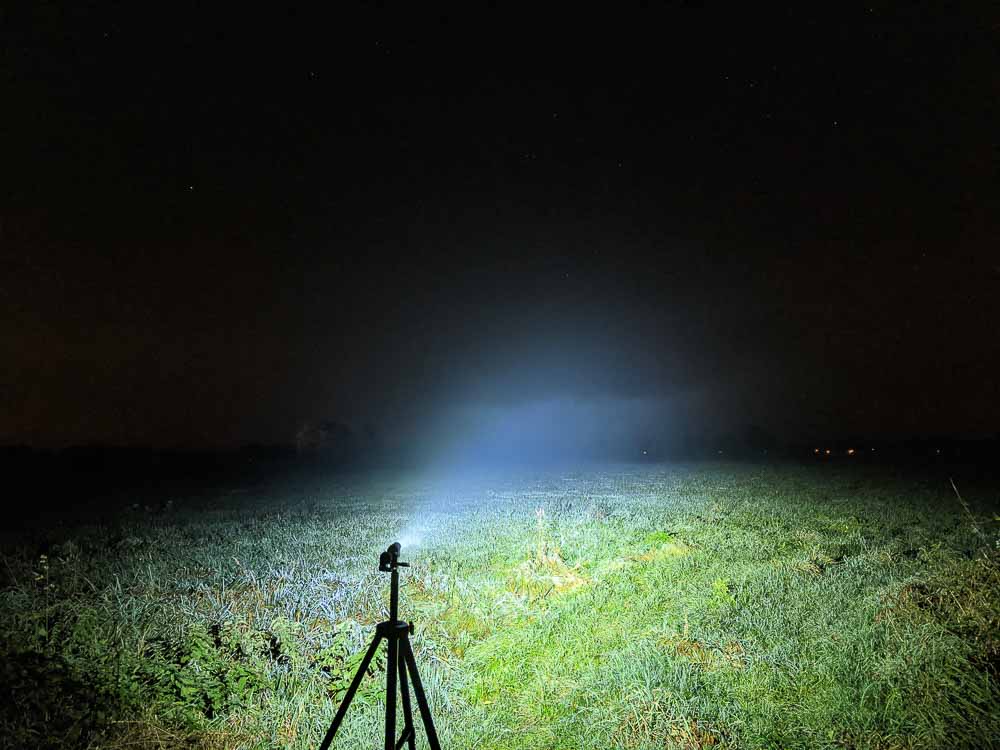
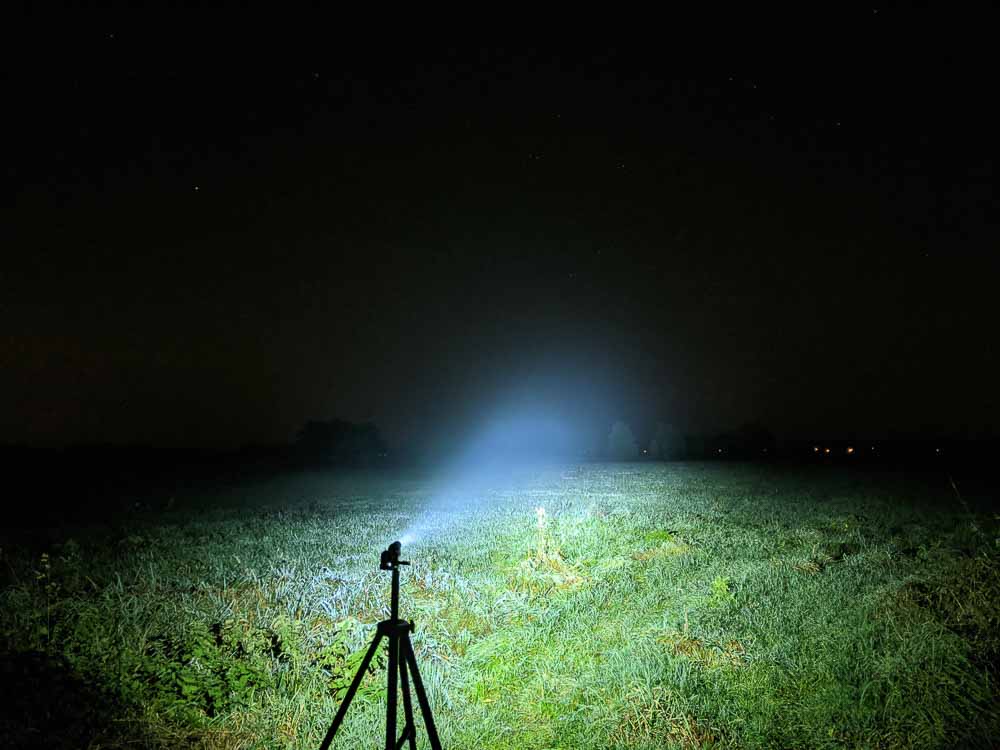
Disclaimer: This flashlight was sent to me for review at no cost by Niwalker. I have not been paid to review, nor have I been holding back on problems or defects.
OVERALL CONCLUSION
Pros
- Comes with various exchangeable lights
- Single or double head use
- Good UI
- Good electronic thermal regulation
Cons
- Bulky head
- Discharges cells too far, no LVP cutoff
- Tailcap is glued
- Finishing is sub-par
- Does not perform as indicated (exaggerated numbers)

3 stars: ★★★
The light itself is quite unique, especially with the double head and the exchangeable light heads. It has many features and the UI is pretty good (it looks a bit like an Anduril UI) and it performs pretty good. It has good regulation, and electronics are looking good.
Although it does not meet its given specs (the given numbers are heavily exaggerated) and it drops down in output fast, but there is really nothing to complain about. The battery was quite low due to the fact that the LVP limit is very low this should have been a proper cutoff at 3V or so.
Personally, it’s not my cup of tea since it’s quite bulky and it carries quite some weight.
Build quality is average, the print on the switch is way off, and I tore 2 o-rings after a couple of times attaching and removing the battery tube. That indicates a subpar connection, probably the ends of the threads need more attention.
It’s a light with good potential, but for the price, you’d expect higher build quality, and that’s the reason I will rate it 3 stars.
Niwalker ES2 for sale:
1lumen selects and reviews products personally. We may earn affiliate commissions through our links, which help support our testing.